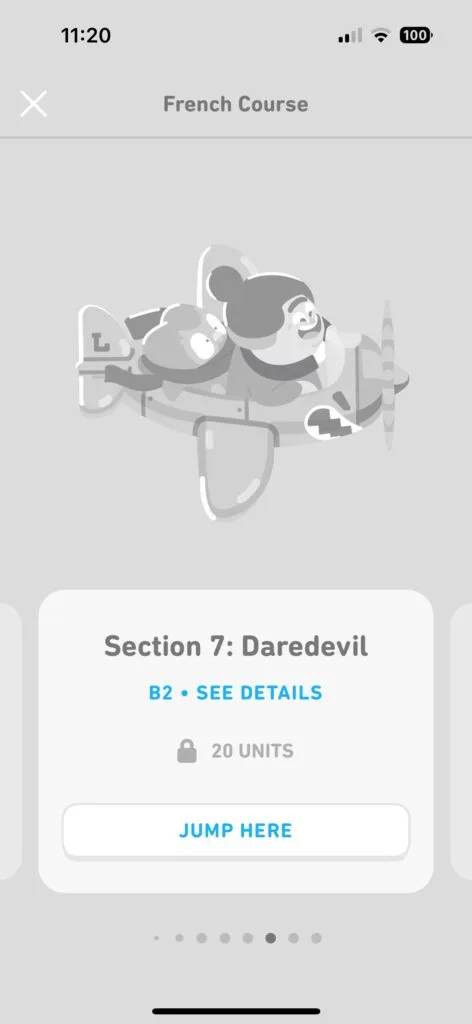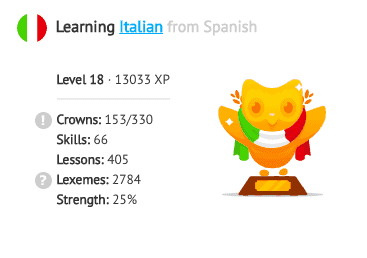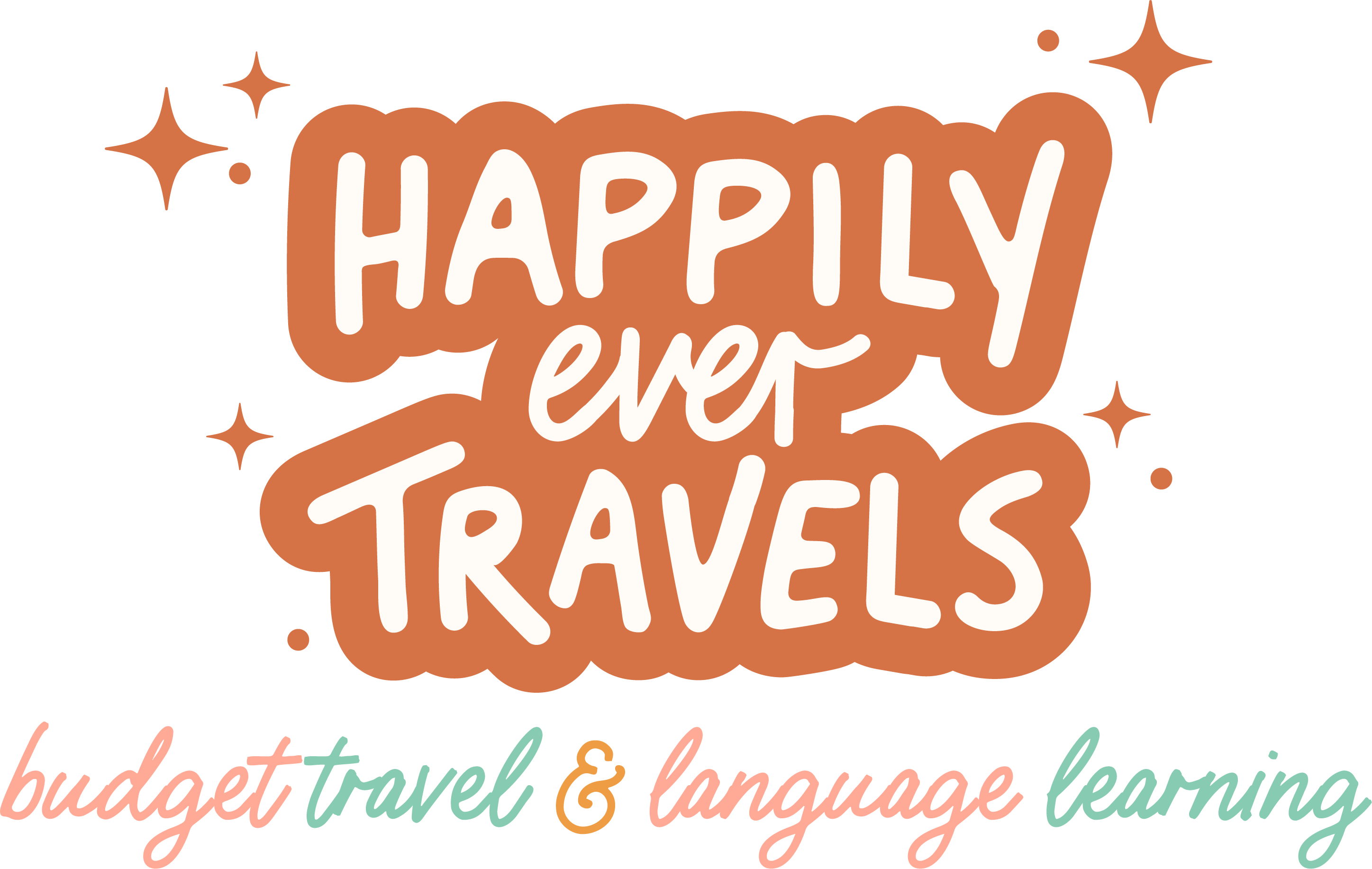Can Duolingo make you fluent? Can it actually help you reach fluency in a new language? Here’s whether it can make you fluent and how you can use Duolingo on your journey to reach fluency.
Can Duolingo Make You Fluent in a Language?
In my opinion, Duolingo on its own CAN NOT make you fluent in a foreign language.
In order to become fluent in a language, it is absolutely necessary to actually speak the language with a native speaker and get hours of practice.
Duolingo can aid in your journey to become fluent, but if you aren’t actively practicing the language with a native speaker or practicing your comprehension skills by listening to native conversations (like using movies, podcasts, YouTube, etc), then you will not become fluent.
Although it may not be able to make you completely fluent on its own, Duolingo can be an important and free resource on your language-learning journey and shouldn’t be ignored!
I use Duolingo in my language plan which has helped me to become fluent in Italian (and I’m working on French right now).
However, I wouldn’t use Duolingo by itself. I use iTalki lessons and Netflix in order to cover all my bases when learning a new language.
I don’t use a ton of language apps since that helps keep things more simple, which means I might actually do them.
What is Fluency?
Let’s go over a bit more about what fluency means since it’s a highly debated topic. Fluency means something different to a lot of people, but the official definition is “the ability to speak or write a foreign language easily and accurately.”
I consider myself to be “fluent” in a language when I have the ability to have a conversation with a native speaker without making either of us feel uncomfortable.
This means that there aren’t a lot of pauses and that besides an accent, the native speaker can speak their language without worrying about whether I understand or not.
If you use the Common European Framework of Reference or CEFR, you can look at your level of language proficiency like this:
- A1 (Beginner)
- A2
- B1
- B2
- C1
- C2 (Very Advanced)
If you only used Duolingo and nothing else, the highest level you could reach on this scale is most likely A2. You can test your level by taking a placement test by CEFR.
Can You Learn a Language with Duolingo?
Yes, I think you can learn a language with Duolingo, however, as I mentioned before, you can’t ONLY use Duolingo to learn a language.
It can get you part of the way there, but you won’t be able to completely learn a language to fluency with just Duolingo.
Some language learners consider Duolingo to be a waste of time but considering that it’s free (as long as you use the free version and not the Super Duolingo / Duolingo Plus subscription) and widely accessible, I disagree.
How Much XP to Be Fluent on Duolingo?
There isn’t an official number of how much XP it takes to be fluent in a language by using Duolingo.
However, you can use your language levels and the Duome to figure out how many vocabulary words you have learned which can be an indicator of how close you are to fluency.
In order to find the number of words you have learned on Duolingo, you need to type duome.eu/yourusernameonduolingo. In my case, this is duome.eu/dayna255732.
Using the Duome, I can see that I have learned almost 3,000 new words in French, Italian, and Spanish.
According to the Universe of Memory, you need to know 4,000 words to be able to have conversations and 8,000 to be at a native-speaker level.

How Much XP I Had When I Felt Fluent in Italian
Although this won’t be true for everyone, I had almost 10,000 XP in my English to Italian Duolingo tree and 13,000 XP in my Spanish to Italian Duolingo tree when I felt “fluent” in Italian.
However, you have to keep in mind that I also watched HOURS of Netflix in Italian and took 46 hours of conversation classes on iTalki during this same time period.
How Fluent Can Duolingo Make You by Itself?
By itself, I think Duolingo can bring you to an A1 level of fluency. This means that you understand basic greetings and have learned a bit of vocabulary. If you use Duolingo religiously, you might be able to get to an A2 level.
How Many Units or Sections to Be Fluent on Duolingo?
On the Duolingo Path, you can click on the sections and it will tell you which level on CEFR scale they are. Since I think “fluent” is probably around B1-B2 level and the level listed on Duolingo is probably a bit higher than it really is, I would say you need to reach the Section on your Path that says B2.
On my French course, this is at Section 7 (which I’m not at yet and I don’t consider myself fluent in French yet!)

For Italian (which is a much less updated course on Duolingo), they don’t have the CEFR scale listed in the Sections.
So for Italian and many of the other languages that don’t list the CEFR scale, I would say you need to finish the whole course and possibly do it in reverse (Italian to English) as well in order to feel like you’re reaching fluency.
I use Duolingo to reinforce vocabulary and grammar structures, especially while watching TV or in between conversation classes.

If you want to know exactly how I use Duolingo, here is my post on the most efficient way to use Duolingo.
If You Finish a Duolingo Course (Tree) Does That Make You Fluent?
I would say that if you finish a Duolingo Path/course, then you are definitely getting closer to fluency!
Finishing a Duolingo course takes a LOT of time (and there are a lot of different ways that you can “finish a tree”) and if you spent that time also watching Netflix or speaking to native speakers, I bet you are fluent by now!
I definitely would NOT recommend spending all the time it takes to finish a Duolingo tree without supplementing that with conversation practice and listening practice since Duolingo mostly focuses on translation exercises.
In the end, does using Duolingo harm you in any way? In my opinion, no.
A lot of times we put way too much pressure on ourselves as we learn a language, thinking that if we are going to put the effort in, it has to be in the most perfect and efficient way.
However, any exposure to your new language is good! One of my all-time favorite quotes is “Anything worth doing is worth doing badly” by G.K. Chesterton.
Duolingo is better for your fluency than Instagram or Facebook! When you get a bit more time, use YouTube or Netflix, then start taking cheap conversation classes and you’ll notice you start understanding and improving!
Language Learning Must-Haves
- iTalki Language Classes: The #1 reason why I’ve been able to learn languages from home. Take conversation classes from a native speaker for only $5-$10 an hour.
- How to Be Fluent Books: Two of my favorite books about language learning have definitely got me super excited about learning a language and I highly recommend reading both!
- Fluent Forever: How to Learn Any Language Fast and Never Forget It
- Fluent in 3 Months: How Anyone at Any Age Can Learn to Speak Any Language from Anywhere in the World
- A Language Planner: Keep track of your scheduled language classes, set language goals, and organize your study schedule with my favorite planner ever.
- Harry Potter in Your Target Language: Reading a beginner book that you’re familiar with is an incredible way to learn vocabulary quickly!
- The Perfect Language Notebook
Read More About Language Learning:
- Contact Duolingo in Different Ways
- Everything You Should Know About Duolingo Status Icons
- Bulgarian on Duolingo?
- Change the Language on Duolingo
- Does Duolingo Offer Slovak?

Dayna Brockbank is a travel and language-learning blogger who has lived around the world but has now settled in Nice, France. She speaks 3 languages at varying levels of fluency: Spanish, Italian, and French, and graduated with a Bachelor’s in Spanish Education. She and her husband focus on making travel part of life by living cheaply and traveling on a budget.

Brenda
Tuesday 5th of January 2021
Thanks for this post! As someone who works with languages and has the same opinion on Duolingo, reading this was refreshing!